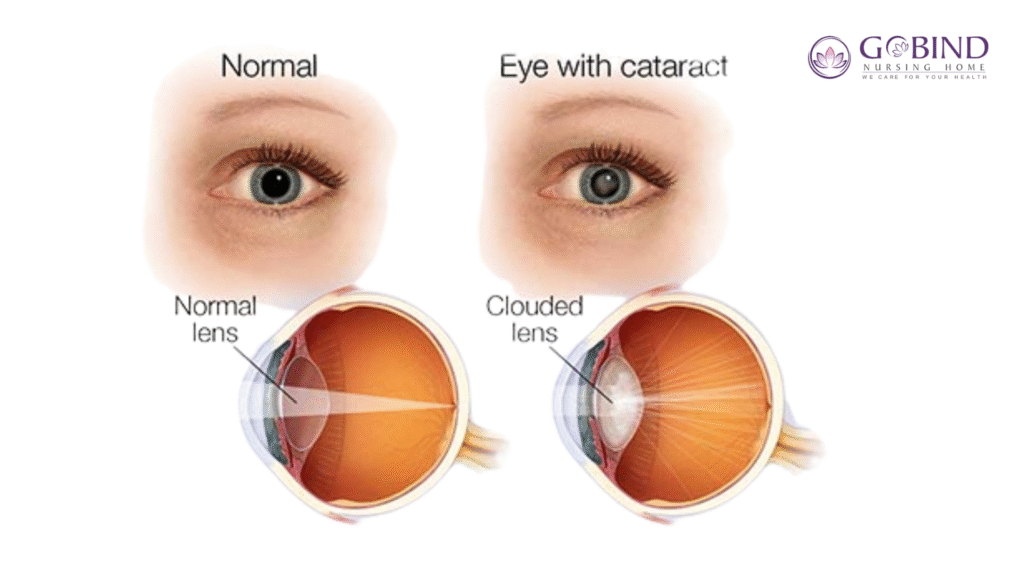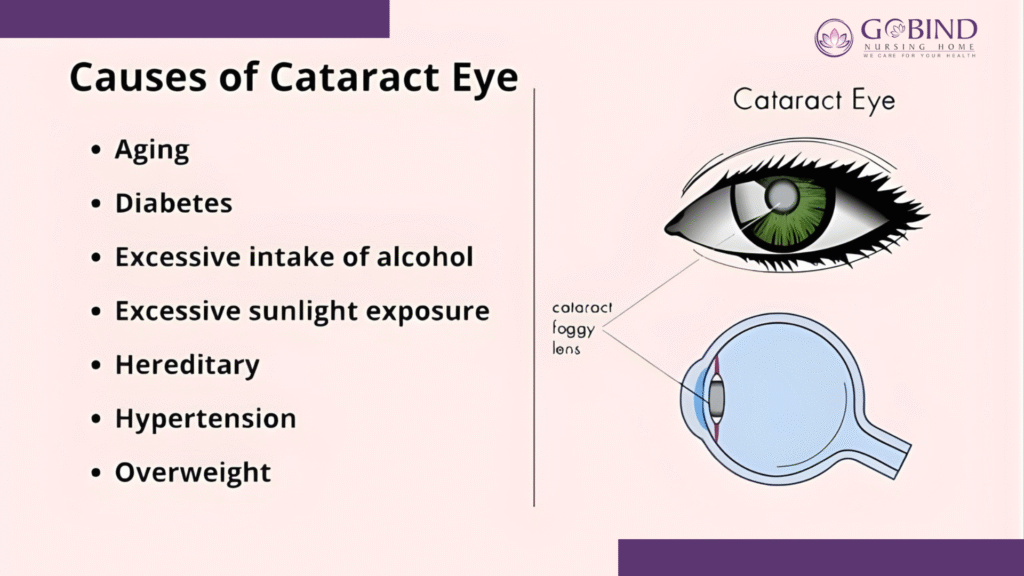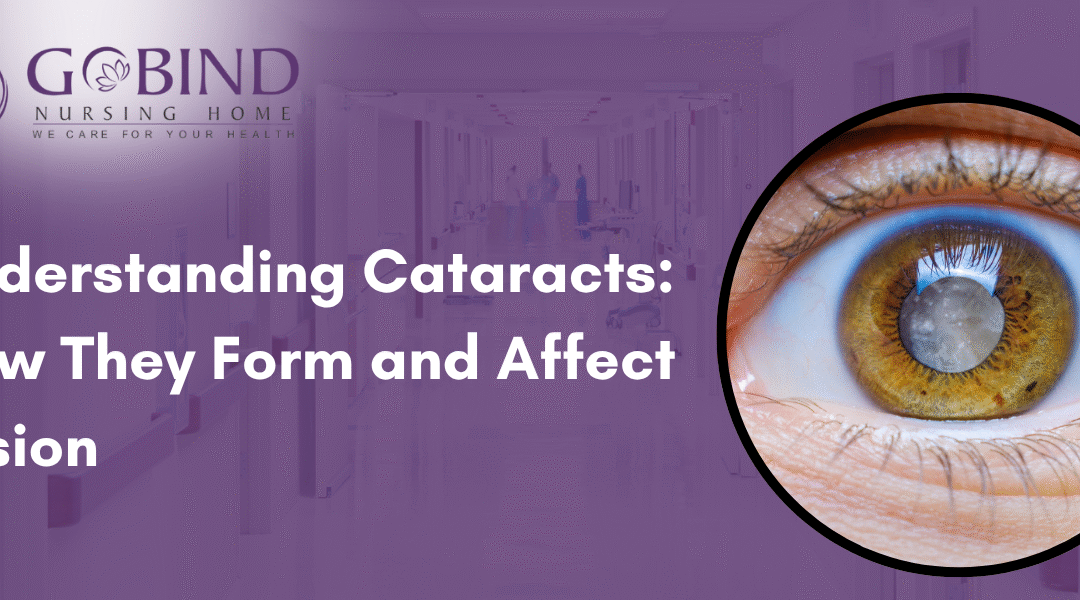Introduction
Clear, sharp vision depends on a transparent lens inside the eye that focuses light onto the retina. But over time, this lens can lose its clarity and become cloudy — a condition known as a cataract.
Cataracts are one of the leading causes of vision loss worldwide, particularly in older adults. Fortunately, cataracts develop gradually and can be treated effectively with modern surgery such as phacoemulsification.
In this detailed guide, we’ll explore what cataracts are, how they form, the different types, how they affect your vision, and the best available treatments — including advanced options at Gobind Eye Care, Hisar under the expertise of super Cataract team comprising Dr. Gulshan Mehta, Dr. Bindiya Dhupper, Dr. Ripan Kaur Kamra.
What Are Cataracts?
A cataract is the clouding or opacification of the eye’s natural lens — the clear, curved structure that helps focus light onto the retina to produce clear images.
When the lens becomes cloudy, light cannot pass through properly, causing blurred or hazy vision — as if you are looking through a foggy window.
Cataracts can affect one or both eyes, though they don’t spread from one to the other.

How Does the Eye Lens Normally Work?
The lens in your eye sits behind the iris (the colored part) and pupil. It’s made mostly of water and proteins arranged in a way that keeps it clear.
The lens:
- Focuses light onto the retina (back of the eye).
- Adjusts shape to help you see objects clearly at different distances (accommodation).
When these proteins begin to break down or clump together, they scatter light instead of focusing it — leading to cloudy, distorted vision.
How Cataracts Form: The Science Behind the Clouding
Cataracts usually develop gradually as part of the natural aging process.
Here’s what happens inside the eye:
- Protein Breakdown:
Over time, proteins in the lens start to deteriorate and clump together. - Loss of Transparency:
These protein clumps block light from passing clearly through the lens. - Progressive Clouding:
The cloudy area slowly grows, causing increasingly blurred or dim vision. - Lens Hardening:
The lens becomes less flexible, making it harder to focus on near objects — often the first sign of cataract development.
Common Causes and Risk Factors
Although aging is the most common cause, several other factors can accelerate cataract formation:
1. Age
Most cataracts appear after age 50, though early signs can start much sooner.
2. UV Radiation
Prolonged exposure to sunlight’s ultraviolet (UV) rays can damage lens proteins.
3. Diabetes
High blood sugar levels can cause chemical changes in the lens, leading to faster clouding.
4. Eye Injuries or Surgery
Any trauma or prior eye operation can trigger cataract formation.
5. Medications
Long-term use of steroids or corticosteroids increases cataract risk.
6. Smoking and Alcohol
These habits contribute to oxidative stress, accelerating lens aging.
7. Genetic Factors
A family history of cataracts can make one more prone to developing them earlier in life.

Types of Cataracts
Cataracts can form in different parts of the lens, each type affecting vision differently.
1. Nuclear Sclerotic Cataract
- Forms in the central (nuclear) part of the lens
- Common with aging
- Gradual yellowing or browning of the lens
- Initially may even improve near vision (“second sight”) but worsens later
2. Cortical Cataract
- Develops in the lens cortex (outer edges)
- White, wedge-shaped streaks extend toward the center
- Causes problems with glare and contrast sensitivity
3. Posterior Subcapsular Cataract
- Forms at the back of the lens
- Progresses quickly
- Causes difficulty reading, seeing in bright light, or glare from headlights
4. Congenital Cataract
- Present at birth or develops in childhood
- May result from infections during pregnancy or genetic factors
5. Secondary or Traumatic Cataract
- Caused by injury, radiation, or certain medications
- Can develop rapidly after trauma
How Cataracts Affect Vision
Cataracts don’t develop overnight. Their impact grows gradually, often unnoticed in early stages.
As they progress, the following symptoms appear:
1. Blurred or Cloudy Vision
Vision becomes misty, making it harder to see fine details.
2. Sensitivity to Light
Bright sunlight or car headlights cause glare and halos.
3. Faded Colors
Colors appear dull, yellowed, or less vibrant.
4. Difficulty Seeing at Night
Low-light conditions become challenging, especially while driving.
5. Double Vision in One Eye
Objects may appear doubled or shadowed.
6. Frequent Changes in Prescription
You may need stronger glasses more often, but even they won’t restore clarity.
These symptoms worsen over time and can significantly affect quality of life — reading, driving, working, or recognizing faces.
Can Cataracts Be Prevented?
While cataracts cannot be completely prevented, certain lifestyle choices can delay their onset:
- Wear UV-protective sunglasses outdoors
- Eat antioxidant-rich foods (vitamin C, E, lutein, and zeaxanthin)
- Quit smoking and limit alcohol
- Manage diabetes and blood pressure effectively
- Have regular eye check-ups, especially after 40
Early detection helps plan timely treatment before the cataract severely affects daily life.
Diagnosis: How Are Cataracts Detected?
Cataracts are diagnosed through a comprehensive eye examination, which includes:
- Visual acuity test – checks how clearly you can see letters or numbers
- Slit-lamp examination – examines structures of the eye under magnification and for any active disease present.
- Retinal examination – to assess how much the cataract affects light entering the eye and the status of retina before Surgery
An our skilled team will determine the cataract’s stage and whether surgery is required or not.

Treatment: How Are Cataracts Treated?
When glasses or brighter lighting no longer help, surgery is the only effective treatment.
Modern cataract surgery removes the cloudy lens and replaces it with a clear intraocular lens (IOL). The most advanced and widely used surgical technique today is phacoemulsification.
Phacoemulsification: The Modern Solution
Phacoemulsification, or phaco surgery, is a minimally invasive cataract removal procedure that uses ultrasound energy to break and remove the cloudy lens.
Key benefits:
- Tiny incision (2–2.8 mm) — no stitches required
- Quick (10–20 minutes) and painless procedure
- Faster recovery and minimal discomfort
- Immediate improvement in vision
- Customizable lens options (monofocal, multifocal, toric, EDOF)
At Gobind Eye Care, Hisar specializes in advanced phaco cataract surgery — helping patients regain bright, clear, and natural vision with personalized care.
Life After Cataract Surgery
After successful surgery:
- Vision improves within 24–48 hours
- Patients can resume light activities within 2–3 days
- Eye drops are prescribed to prevent infection
- Follow-up visits ensure smooth healing
With modern IOLs, many patients enjoy glasses-free vision for most tasks — reading, driving, and outdoor activities.
When to See a Doctor
You should schedule an eye check-up if you experience:
- Cloudy or blurred vision
- Glare or halos around lights
- Colors appearing faded
- Difficulty reading or driving at night
Early diagnosis helps prevent complications and allows for easier, safer surgery.
Conclusion
Cataracts are a natural part of aging — but they don’t have to limit your vision or independence. Understanding how cataracts form and affect vision is the first step toward maintaining lifelong eye health.
With today’s modern technology like phacoemulsification, cataract surgery has become safe, quick, and highly effective, restoring not just sight but confidence and quality of life.
If you’re noticing changes in your vision, visit our Expert team at Gobind Eye Care, Hisar for a comprehensive eye check-up and expert guidance on cataract treatment.
See the world clearly again — because your vision deserves the best care.

